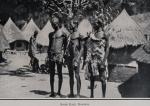Tremearne, The Tailed Head-Hunters of Nigeria - An Account of an Official's Seve
The Tailed Head-Hunters of Nigeria – An Account of an Official’s Seven Years’ Experiences in the Northern Nigerian Pagan Belt, and a Description of the Manners, Habits, and Customs of the Native Tribes. With 38 Illustrations & a Map.
London, Seeley, Service & Co. Limited, 1912. 15.5 cm x 22.5 cm. Frontispiece, XVI, 342 pages. 38 illustrations. Fold-out map near rear showing ‘Northern Nigeria for “The Tailed Head-Hunters of Nigeria.”’ Hardcover [publisher’s original orange cloth] with gilt lettering on spine. Gilt lettering and pictorial to front board. Gilt top edge. Very good condition with only minor signs of external wear. Minor abrasions to board cloth near spine. Slight tanning throughout. Interior bright and clean. Binding good and firm. Text-block tight and square.
Includes, for example, the following: Mohammedans v. Pagans / The Tailed Head-Hunters / Customs and Superstitions / Courtship, Marriage, Divorce and Child-Birth / Food and Drink / Music and Dancing / Modes of Travelling / Hausa Folklore etc
″One of my aims in writing this book has been to show how much the uncivilised natives of Northern Nigeria resemble some other aboriginal races, possibly even our remote ancestors, and incidentally, to prove that they are by no means as black as in many ways as they are painted.” Having served in different parts of Africa for the greater part of ten years, first as a Military then as a Police Officer, and subsequently in a Political and Judicial capacity, I have possibly a wider view of West African things in general than many writers on the country. The native is certainly not the equal of the European, but he is still worthy of consideration.”
As made clear by the title of the work, headhunting is given much attention by the author. Explaining the practice, Tremearne looks at it’s cultural causes: “Their religion is conducive to warlike prowess, for the strongest on earth will be the most influential in the spirit world, and also, the ghost of a slaughtered enemy must serve the ghost of him who has taken the head. Again, the hero is the admiration of all the ladies of all the belles of the village; and last, but not by any means least, the effect of the stories and songs of the prowess and fame of bygone heroes must be considerable.” (p.153-54)
The author’s intention is also to focus on the more grislier dietary habits of some of the natives. He does this at some length, seeking explanations for cannibalism arising from food scarcity to deeper cultural significances, taking as evidence other instances from across the globe and throughout history.
Major Arthur John Newman Tremearne (1877 – 1915) was a British barrister, major (″D” Company. 1st/22nd Battalion London Regiment attached to the 8th Battalion Seaforth Highlanders), anthropologist and ethnographer. (Wikipedia)
He arrived in West Africa in 1900 as a Special Service Officer to join the intriguing-sounding ‘War of the Golden Stool,’ – or what is also known by the more mundane titles, ‘Third Ashanti Expedition’ or ‘Fifth Ashanti War – and thus began his long association with the region. The book – part history, part narrative account, part ethnograhical study – resulted from Tremearne’s experiences.
His published work in anthropology and folklore was considerable. He contributed several important papers to the Journal of the Royal Anthropological Institute, to the Journal of the Royal Society of Art, Journal of the Society of Comparative Legislation, and to Folk-Lore. He was also the author of several important works: The Niger and the West Sudan, or the West African Note Book (1910), Fables and Fairy Tales for Little Folk, or Uncle Remus in Hausa Land (1910) in which he was assisted by his wife; The Tailed Hunters of Nigeria (1912), Hausa Superstitions and Customer (1913) (profile available from The Masonic Great War Project website)
- Keywords: Africa · Africa – Rare · Africa, West · Africana Collection of Rare Books · British · British Colonial Administration · British Colonial History · British Empire · British Imperial · British Imperialism · Cannibalism · colonial · Colonial administrators · Colonial History · Colonial Wars · Colonialism · Funerals and Burials, Rituals etc · Hunting · Imperialism · Native, Rituals and Customs · Natives · Nigeria · Religion · Religion and Culture · Religion, Primitive · Scramble for Africa · Victorian Era · West Africa
- Language: English
- Inventory Number: 120221AB
EUR 105,--
© 2025 Inanna Rare Books Ltd. | Powered by HESCOM-Software













